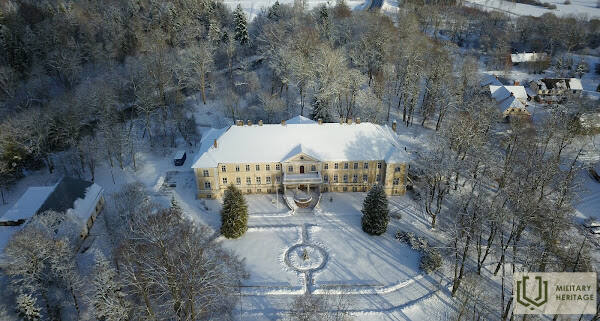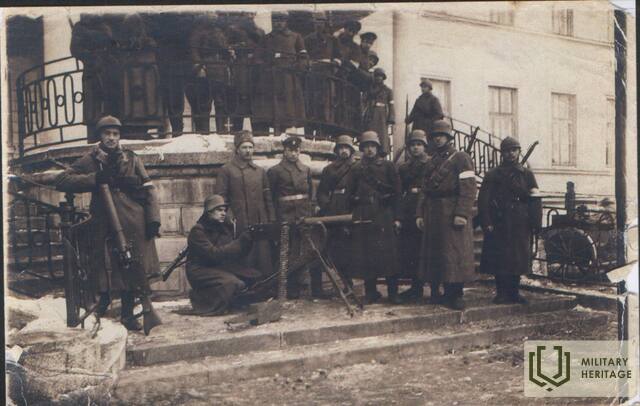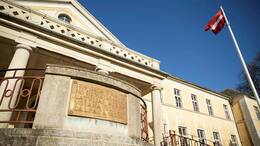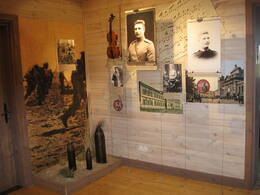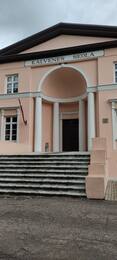Generolo Ridiger von der Goltz vizitas į Rudbārži 1919 m. vasario mėn
1919 m. vasarį, po sėkmingos antivokiškos kampanijos Suomijoje, vokiečių generolas Ridiger von der Goltz buvo paskirtas vokiečių ginkluotų junginių Kurše ir Šiaurės Lietuvoje, įskaitant Landwehrą, kuriam priklausė ir 1-asis Latvijos batalionas, vadu. Vizito fronte metu 1919 m. vasarį jis taip pat atvyko į Rudbāržius. Bataliono specialiųjų užduočių karininkas leitenantas Jānis Ķīselis aprašė generolo vizitą savo memuaruose.
Gavęs žinią apie laukiamą svečią, pulkininkas (Oskaras Kalpaksas. red.) įsakė tinkamai iškepti stirniuką, kad būtų kuo jį pasitikti. Pilies kieme studentai rikiavosi į pratybas (Atskiros studentų kuopos kareiviai. red.), o kiti berniukai, laisvi nuo tarnybos, važinėjo aplink juos. Kažkur netoliese riaumodamas pravažiavo automobilis. Pulkininkas liepė man išeiti ir pasitikti svečio prie durų, bet pats liko viduje. Mūsiškiai, kurie atsitiktinai buvo netoliese, tinkamai pasveikino artėjantį generolą, bet jokio bendro įsakymo negirdėti. Iš automobilio išlipo generolas grafas fon der Golcas su štabo karininku. Taip atrodė šis garsus karys ir Suomijos gelbėtojas. Aukštas, žilaplaukis, didingo sudėjimo, jis paliko įspūdingą įspūdį.
Pasisveikinome, aš atsistojau priekyje ir paprašiau svečių užeiti. Generolo kakta susiraukšlėjo – senam prūsų aristokratui nepatiko, labai nepatiko priėmimas Latvijos valstiečių karių štabe. Ir jis tikriausiai žinojo apie mūsų pokalbius su Obersthofu apie savo vizitą. Kai įėjome, pulkininkas Kalpakas priėjo prie mūsų per prieškambarį. Abu vyrai atidžiai stebėjo vienas kito žvilgsnius, pasisveikino, ir pulkininkas palydėjo generolą toliau.
Mažame, apvaliame kabinete du svečiai sėdėjo vienoje stalo pusėje, pulkininkas su kapitonu Balodžiu – kitoje, o aš – stalo gale, nes pulkininkas nemokėjo vokiškai. Po trumpų, informatyvių klausimų apie mūsų pajėgas ir padėtį fronte, fon der Golzas iškart ėmėsi klausimo, kuris jam buvo arčiausiai ir labiausiai skaudino. Jam buvo pranešta apie mūsų paskelbtą mobilizaciją Tāši-Padure (Mūsdēnas Kalvene. red.) ir kad pulkininkas išsiuntė karininkus į kai kurias parapijas kviesti žmones mums padėti. Generolas tuoj pat gana susijaudinusiu balsu pradėjo kalbėti, kad jis yra atsakingas už visas ginkluotąsias pajėgas šioje teritorijoje ir kad negali leisti jokių mobilizacijų, nes visi latviai yra bolševikai ir jei mes juos mobilizuosime, vėliau jis nebegalės būti tikras, kad jie neužpuls jo dalinių. Jokiomis aplinkybėmis tokių mobilizuotų žmonių negalima siųsti prieš Raudonąją armiją, nes jie tuoj pat pereis į kitą pusę. Pulkininkas Kalpakas lygiai taip pat energingai atmetė šiuos teiginius ir savo ruožtu pabrėžė, kad Latvijos žmonės pasiruošę kovoti su fanatikais, tik jie patys, vokiečiai, tam visokeriopai trukdo ir trukdo. Grafo akyse sužibo blogio kibirkštis; jis tikriausiai nesitikėjo tokio ryžtingo pasipriešinimo jo ketinimams čia. Jie aptarė dar keletą klausimų apie mūsų tiekimą ir būsimą bendrą puolimą. Apskritai grafas nebuvo labai patenkintas derybomis, jis labai mažai ragavo mūsų siūlomų pietų ir netrukus išvyko. Kai išėjome į lauką, fon der Golcas atsisuko į mane ir abejingai tarė: „Aš nepasitikiu Lettenu.“ Tarsi numatydamas ateities laikus, nedvejodamas atsakiau: „Aš irgi, pone grafe.“ Vėliau radau grafo atvirumo paaiškinimą jo knygoje „Meine Sendung in Finnland und im Baltikum“, kurioje, rašydamas apie šį vizitą, jis mini, kad pulkininkas Kalpakas turėjo sumanų adjutantą ir vertėją – pusiau žydą. Taigi mano kreiva nosis išprovokavo generolo atvirumą. Taip baigiasi šis pirmasis ir paskutinis fon der Golco vizitas į Latvijos būstinę.
Kai išeidavome į ilgą žvalgybinį žygį, dažnai eidavome maudytis į dvaro pirtį, ir šią sporto šaką pulkininkas Kalpakas labai gerbė. Iš pradžių eidavome kartu su juo, vėliau bandydavome patekti į pirtį arba prieš jį, arba po jo, nes pulkininkas visada taip įsisiautėdavo, kad kiti tik šliauždavo ir bandydavo išlįsti į priekinį kambarį. Kai Kalpakas visiškai atvėsdavo, visu greičiu iššoko iš pirties į gilią pusnį, kruopščiai ją pervažiavo ir vėl grįžo į pirtį. Iš prigimties mūsų vadas buvo labai paprastas ir negalėjo pakęsti jokio puikavimosi. Bausmių buvo nedaug, bet vyravo griežta draugiška drausmė. Kaip kuriozą prisimenu tokį atvejį: mūsų „džigitas“ kapitonas Zariņšas arba nuplėšė senas kelnes, arba jas paleido ir įsivaizdavo, kad iš biliardo stalo dulkių Rudbāržių pilyje galima pasiūti porą padorios kelnės. Daug negalvodamas, jis nuplėšė dulkes, savo rankomis pasiuvo labai prabangų kostiumą ir vaikščiojo su žaliais apatiniais kaip papūga. Tačiau jam ilgai jo nereikėjo dėvėti, nes netrukus gavo gerą pulkininko pylos ir dvi valandas po kardu (Bausmės rūšis. Red.).
Kīselis J. Kovoje už Tėvynę. Ryga, 1936.
Susijusi laiko juosta
Susijusios vietos
Rudbāržių dvaro pilis ir 1-ojo Latvijos atskirojo bataliono atminimo lenta
Pilis yra Rudbāržuose, prie Rygos–Liepojos greitkelio A9. Priešais pastatą yra atminimo lenta, skirta Oskaro Kalpakos bataliono žygdarbiams atminti.
Pilis buvo pastatyta 1835 m. baronienės Theos von Firks įsakymu kaip baronų fon Firksų šeimos nuosavybė. 1905 m. gruodžio 15 d. dvaro rūmus sudegino revoliucionieriai. Po trejų metų prasidėjo restauravimo darbai, vadovaujami architekto L. Reinierso.
Latvijos nepriklausomybės karo metu Rudbāržių pilis tarnavo kaip bazė ir štabas koviniams veiksmams Ventos upės pakrantėje, kuriems vadovavo pulkininko Oskaro Kalpako 1-asis atskirasis Latvijos batalionas.
Vėliau pilis buvo naudojama kaip Latvijos armijos kareivių poilsio bazė. 1938 m. pilis buvo atstatyta.
Antrojo pasaulinio karo metu pastate buvo įsikūrusi vokiečių armijos kareivių ligoninė, o pokario metais – miško darbininkų mokykla. 1962 m. pilyje įsikūrė Rudbāržių mokykla, kuri 1991 m. buvo pavadinta Oskaro Kalpako vardu. Rudbāržių dvaro didvyrių salė buvo restauruota 2016 m. Šiuo metu mokykla uždaryta, tačiau ateinančiais metais pastate planuojama įkurti Oskaro Kalpako vardu pavadintą profesinę karo vidurinę mokyklą.
Oskaro Kalpako muziejus ir memorialinė vieta „Airītes“
Oskaro Kalpako muziejus ir memorialinė vieta „Airītes“ yra tarp Saldaus ir Skrundos, netoli greitkelio A9. Parodoje pateikiama išsami informacija apie pulkininką Oskarą Kalpaką ir jo batalioną, taip pat pristatoma Latvijos nacionalinės armijos ir memorialinės vietos „Airītes“ istorija. Parodoje pulkininką Oskarą Kalpaką pristatoma kaip asmenybę, kaip karį ir kaip kovotoją už Latvijos nepriklausomybę. Parodoje taip pat yra garso įrašų latvių, anglų ir vokiečių kalbomis. Juose pabrėžiama 1918/1919 m. istorinių įvykių svarba saugant Latvijos valstybingumą. Muziejaus pastatas yra restauruotas.
Įėjimas nemokamas; ekskursija su gidu – mokama. Komplekse yra poilsio zona, parkas, kliūčių ruožas, galima lankyti įvairius užsiėmimus, yra seminarų salė iki 30 žmonių.
Tašas - Padurės dvaras
Tasi-Padurės dvaro pilis dabar žinoma kaip Kalvenes pradinė mokykla, įkurta 1922 m. Mokyklos pastatas buvo pastatytas XIX a. vėlyvojo klasicizmo stiliumi kaip grafo Keizerlingo medžioklės namelis.
1919 metų pradžioje čia susirinko ir į dvarą atvyko pirmieji į mobilizacijos šaukimą atsiliepę mobilizacijos vyrai. 1919 metų sausio 22 dieną čia buvo įkurtas Latvijos atskirasis kavalerijos dalinys, kurio vienas vadų sausio 24 dieną išvyko į O. Kalpakso vadovaujamą 1-ąjį Latvijos atskirąjį batalioną. Visas dalinys (iš viso apie 80 kareivių), vadovaujamas vado Arnoldo Artumo-Hartmanio, į Rudbāržius atvyko kovo 1 dieną.
Kalvenės pradinė mokykla yra nacionalinis kultūros paminklas. 1960-aisiais pilis buvo renovuota ir pritaikyta mokyklos poreikiams.




